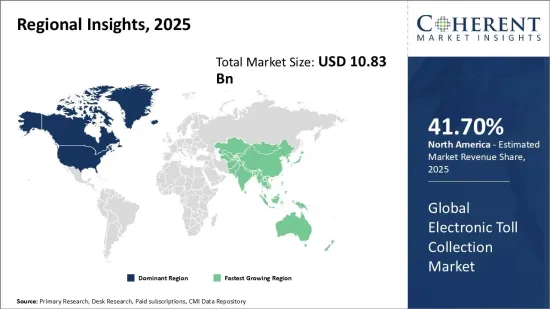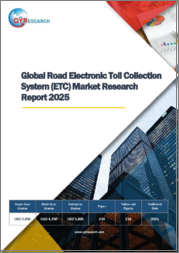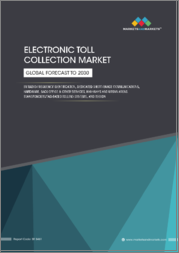
|
시장보고서
상품코드
1699491
전자요금징수(ETC) 시장 : 유형별, 제공 제품별, 기술별, 지역별Electronic Toll Collection Market, By Type, By Offering, By Technology, By Geography |
||||||
세계 전자요금징수(ETC) 시장은 2025년에 108억 3,000만 달러, 2032년까지 176억 2,000만 달러에 달할 것으로 예상되며, 2025년부터 2032년까지 연평균 7.2%의 성장률(CAGR)을 나타낼 것으로 예측됩니다.
| 보고 범위 | 보고서 상세 내용 | ||
|---|---|---|---|
| 기준 연도 | 2024년 | 2025년 시장 규모 | 108억 3,000만 달러 |
| 실적 데이터 | 2020-2024년 | 예측 기간 | 2025-2032년 |
| 예측 기간(2025-2032년) CAGR | 7.20% | 2032년 금액 예측 | 176억 2,000만 달러 |

세계 전자 통행료 징수 시장은 교통 관리 강화, 이용자 편의성 향상 등 다양한 장점으로 인해 최근 몇 년 동안 큰 견인차 역할을 하고 있습니다. 전자 통행료 징수는 유료도로, 고속도로, 교량, 터널을 이용하는 차량이 정차하지 않고도 요금의 현금 없는 거래를 용이하게 하는 다양한 자동화 및 반자동화 시스템의 사용을 수반합니다. 수년 동안 RFID, DSRC 등의 첨단 기술을 통해 보다 빠르고 효율적인 거래가 가능해졌습니다. 보다 스마트한 교통 인프라 구축을 위한 정부의 투자 확대와 소비자들 사이에서 비접촉식 결제 시스템에 대한 선호도가 높아짐에 따라 향후 몇 년 동안 전자요금징수(ETC) 시장의 강력한 성장을 가속할 것으로 예상됩니다.
시장 역학:
세계 전자 통행료 징수 시장은 몇 가지 요인으로 인해 강력한 성장세를 보이고 있습니다. 도시화가 진전되고 도로 혼잡도가 증가함에 따라 교통 관리를 강화하고 요금소에서 대기 시간을 줄이기 위해 전자 요금 징수를 활용하는 국가가 증가하고 있습니다. 소비자들 사이에서 비접촉식 결제 기술이 채택되고 있으며, 전자 요금 태그의 소유자가 증가함에 따라 시장 성장을 더욱 촉진하고 있습니다. 그러나 전자 요금 인프라 설치에 따른 높은 초기 비용은 특히 가격에 민감한 신흥국 시장에서 이러한 시스템의 보급을 저해할 수 있습니다. 인공지능 및 빅데이터 분석과 같은 혁신적인 기술의 도입은 사용자 경험을 개선하고 운영을 최적화하기 위해 첨단 기능을 통합할 수 있는 새로운 기회를 제공하며, 5G 커넥티비티와 신흥 커넥티비티 플랫폼의 지속적인 통합은 장기적인 성장 전망을 제시합니다.
본 조사의 주요 특징
세계의 전자요금징수(ETC) 시장을 상세하게 분석했으며, 2024년을 기준 연도로 하여 예측 기간(2025-2032년) 시장 규모와 연평균 성장률(CAGR)에 대해 조사 분석하여 전해드립니다.
또한, 다양한 부문에 걸친 잠재적 수익 창출 기회를 파악하고, 이 시장의 매력적인 투자 제안 매트릭스를 설명합니다.
또한 시장 성장 촉진요인, 억제요인, 기회, 신제품 출시 및 승인, 시장 동향, 지역별 전망, 주요 기업의 경쟁 전략 등에 대한 중요한 고찰을 제공합니다.
이 보고서는 세계 전자요금징수(ETC) 시장의 주요 기업들을 기업 개요, 제품 포트폴리오, 주요 특징, 성과, 전략 등의 매개 변수를 기반으로 프로파일링합니다.
조사 대상 주요 기업으로는 Kapsch TrafficCom AG(오스트리아), Conduent, Inc. Technologies AG(독일),Siemens AG(독일),EFKON GmbH(오스트리아),Neology, Inc.(미국),FEIG ELECTRONIC(독일),Q-Free ASA(노르웨이),GeoToll(미국),Toll Collect GmbH(독일), STAR Systems International(홍콩), SICE(스페인) 등이 있습니다.
이 보고서의 통찰력을 통해 마케팅 담당자와 기업 경영진은 향후 제품 출시, 유형화, 시장 확대, 마케팅 전략에 대한 정보에 입각한 의사결정을 내릴 수 있습니다.
이 보고서는 투자자, 공급업체, 제품 제조업체, 유통업체, 신규 시장 진출기업, 재무 분석가 등 업계의 다양한 이해관계자를 대상으로 합니다.
이해관계자들은 세계 전자요금징수(ETC) 시장 분석에 사용되는 다양한 전략 매트릭스를 통해 의사결정을 쉽게 내릴 수 있습니다.
목차
제1장 조사 목적과 전제조건
- 조사 목적
- 전제조건
- 약어
제2장 시장 전망
- 보고서 설명
- 시장 정의와 범위
- 주요 요약
제3장 시장 역학, 규제, 동향 분석
- 시장 역학
- 영향 분석
- 주요 하이라이트
- 규제 시나리오
- 제품 발매/승인
- PEST 분석
- PORTER 분석
- 시장 기회
- 규제 시나리오
- 주요 발전
- 업계 동향
제4장 세계의 전자요금징수(ETC) 시장, 유형별, 2020년-2032년
- 트랜스폰더/태그 기반 통행요금 징수 시스템
- 기타
제5장 세계의 전자요금징수(ETC) 시장, 제공 제품별, 2020년-2032년
- 하드웨어
- 백 오피스 및 기타 서비스
제6장 세계의 전자요금징수(ETC) 시장, 기술별, 2020년-2032년
- 무선 주파수 식별(RFID)
- 전용 근거리 통신(DSRC)
제7장 세계의 전자요금징수(ETC) 시장, 지역별, 2020년-2032년
- 북미
- 라틴아메리카
- 유럽
- 아시아태평양
- 중동
- 아프리카
- 시장 규모와 예측, 국가/지역별, 금액
- 남아프리카공화국
- 북아프리카
- 중앙아프리카
제8장 경쟁 구도
- Kapsch TrafficCom AG(Austria)
- Conduent, Inc.(US)
- TransCore(US)
- Thales Group(France)
- Cubic Corporation(US)
- Infineon Technologies AG(Germany)
- Siemens AG(Germany)
- EFKON GmbH(Austria)
- Neology, Inc.(US)
- FEIG ELECTRONIC(Germany)
- Q-Free ASA(Norway)
- GeoToll(US)
- Toll Collect GmbH(Germany)
- STAR Systems International(Hong Kong)
- SICE(Spain)
제9장 애널리스트의 제안
- Wheel of Fortune
- 애널리스트의 견해
- Coherent Opportunity Map
제10장 참고 문헌과 조사 방법
- 참고 문헌
- 조사 방법
- 출판사에 대해
Global Electronic Toll Collection Market is estimated to be valued at US$ 10.83 Bn in 2025 and is expected to reach US$ 17.62 Bn by 2032, growing at a compound annual growth rate (CAGR) of 7.2% from 2025 to 2032.
| Report Coverage | Report Details | ||
|---|---|---|---|
| Base Year: | 2024 | Market Size in 2025: | USD 10.83 Bn |
| Historical Data for: | 2020 To 2024 | Forecast Period: | 2025 To 2032 |
| Forecast Period 2025 to 2032 CAGR: | 7.20% | 2032 Value Projection: | USD 17.62 Bn |

The global electronic toll collection market has been gaining significant traction over the past few years owing to the various advantages it offers enhanced traffic management and improved convenience for users. Electronic toll collection involves the use of various automated and semi-automated systems that facilitate cashless transactions of toll charges for vehicles using toll roads, highways, bridges, and tunnels without requiring them to stop. Over the years, advanced technologies such as RFID, DSRC, and others have enabled higher transaction speeds and efficiencies. Rising investments by governments towards the development of smarter transportation infrastructure along with growing preference for contactless payment systems among consumers are expected to drive strong growth in the electronic toll collection market in the coming years.
Market Dynamics:
The global electronic toll collection market is witnessing strong growth driven by several factors. Rising urbanization and increasing road congestion levels are prompting more countries to leverage electronic toll collection to enhance traffic management and reduce waiting times at toll plazas. Growing adoption of contactless payment technologies among consumers along with increasing ownership of electronic toll tags are further propelling the market growth. However, high initial costs associated with setting up electronic toll infrastructure could hinder the widespread adoption of these systems particularly in price sensitive developing markets. Introduction of innovative technologies, such as artificial intelligence and big data analytics, provide new opportunities to integrate advanced features for improved user experience and operations optimization. Ongoing integration of 5G connectivity and emerging connectivity platforms also offer growth prospects over the long term.
Key Features of the Study:
This report provides in-depth analysis of the global electronic toll collection market, and provides market size (US$ Billion) and compound annual growth rate (CAGR%) for the forecast period (2025-2032), considering 2024 as the base year
It elucidates potential revenue opportunities across different segments and explains attractive investment proposition matrices for this market
This study also provides key insights about market drivers, restraints, opportunities, new product launches or approvals, market trends, regional outlook, and competitive strategies adopted by key players
It profiles key players in the global electronic toll collection market based on the following parameters - company highlights, products portfolio, key highlights, financial performance, and strategies
Key companies covered as a part of this study include Kapsch TrafficCom AG (Austria), Conduent, Inc. (US), TransCore (US), Thales Group (France), Cubic Corporation (US), Infineon Technologies AG (Germany), Siemens AG (Germany), EFKON GmbH (Austria), Neology, Inc. (US), FEIG ELECTRONIC (Germany), Q-Free ASA (Norway), GeoToll (US), Toll Collect GmbH (Germany), STAR Systems International (Hong Kong), and SICE (Spain)
Insights from this report would allow marketers and the management authorities of the companies to make informed decisions regarding their future product launches, type up-gradation, market expansion, and marketing tactics
The global electronic toll collection market report caters to various stakeholders in this industry including investors, suppliers, product manufacturers, distributors, new entrants, and financial analysts
Stakeholders would have ease in decision-making through various strategy matrices used in analyzing the global electronic toll collection market
Market Segmentation
- Type Insights (Revenue, USD Bn, 2020 - 2032)
- Transponder/Tag-based Tolling Systems
- Others
- Offering Insights (Revenue, USD Bn, 2020 - 2032)
- Hardware
- Back-office and Other Services
- Technology Insights (Revenue, USD Bn, 2020 - 2032)
- Radio Frequency Identification (RFID)
- Dedicated Short-Range Communication (DSRC)
- Regional Insights (Revenue, USD Bn, 2020 - 2032)
- North America
- U.S.
- Canada
- Latin America
- Brazil
- Argentina
- Mexico
- Rest of Latin America
- Europe
- Germany
- U.K.
- Spain
- France
- Italy
- Russia
- Rest of Europe
- Asia Pacific
- China
- India
- Japan
- Australia
- South Korea
- ASEAN
- Rest of Asia Pacific
- Middle East
- GCC Countries
- Israel
- Rest of Middle East
- Africa
- South Africa
- North Africa
- Central Africa
- Key Players Insights
- Kapsch TrafficCom AG (Austria)
- Conduent, Inc. (US)
- TransCore (US)
- Thales Group (France)
- Cubic Corporation (US)
- Infineon Technologies AG (Germany)
- Siemens AG (Germany)
- EFKON GmbH (Austria)
- Neology, Inc. (US)
- FEIG ELECTRONIC (Germany)
- Q-Free ASA (Norway)
- GeoToll (US)
- Toll Collect GmbH (Germany)
- STAR Systems International (Hong Kong)
- SICE (Spain)
Table of Contents
1. Research Objectives and Assumptions
- Research Objectives
- Assumptions
- Abbreviations
2. Market Purview
- Report Description
- Market Definition and Scope
- Executive Summary
- Global Electronic Toll Collection Market, By Type
- Global Electronic Toll Collection Market, By Offering
- Global Electronic Toll Collection Market, By Technology
- Global Electronic Toll Collection Market, By Region
3. Market Dynamics, Regulations, and Trends Analysis
- Market Dynamics
- Impact Analysis
- Key Highlights
- Regulatory Scenario
- Product Launches/Approvals
- PEST Analysis
- PORTER's Analysis
- Market Opportunities
- Regulatory Scenario
- Key Developments
- Industry Trends
4. Global Electronic Toll Collection Market, By Type, 2020-2032, (USD Bn)
- Introduction
- Market Share Analysis, 2025 and 2032 (%)
- Y-o-Y Growth Analysis, 2021 - 2032
- Segment Trends
- Transponder/Tag-based Tolling Systems
- Introduction
- Market Size and Forecast, and Y-o-Y Growth, 2020-2032, (USD Bn)
- Others
- Introduction
- Market Size and Forecast, and Y-o-Y Growth, 2020-2032, (USD Bn)
5. Global Electronic Toll Collection Market, By Offering, 2020-2032, (USD Bn)
- Introduction
- Market Share Analysis, 2025 and 2032 (%)
- Y-o-Y Growth Analysis, 2021 - 2032
- Segment Trends
- Hardware
- Introduction
- Market Size and Forecast, and Y-o-Y Growth, 2020-2032, (USD Bn)
- Back-office and Other Services
- Introduction
- Market Size and Forecast, and Y-o-Y Growth, 2020-2032, (USD Bn)
6. Global Electronic Toll Collection Market, By Technology, 2020-2032, (USD Bn)
- Introduction
- Market Share Analysis, 2025 and 2032 (%)
- Y-o-Y Growth Analysis, 2021 - 2032
- Segment Trends
- Radio Frequency Identification (RFID)
- Introduction
- Market Size and Forecast, and Y-o-Y Growth, 2020-2032, (USD Bn)
- Dedicated Short-Range Communication (DSRC)
- Introduction
- Market Size and Forecast, and Y-o-Y Growth, 2020-2032, (USD Bn)
7. Global Electronic Toll Collection Market, By Region, 2020 - 2032, Value (USD Bn)
- Introduction
- Market Share (%) Analysis, 2025, 2028 & 2032, Value (USD Bn)
- Market Y-o-Y Growth Analysis (%), 2021 - 2032, Value (USD Bn)
- Regional Trends
- North America
- Introduction
- Market Size and Forecast, By Type, 2020 - 2032, Value (USD Bn)
- Market Size and Forecast, By Offering, 2020 - 2032, Value (USD Bn)
- Market Size and Forecast, By Technology, 2020 - 2032, Value (USD Bn)
- Market Size and Forecast, By Country, 2020 - 2032, Value (USD Bn)
- U.S.
- Canada
- Latin America
- Introduction
- Market Size and Forecast, By Type, 2020 - 2032, Value (USD Bn)
- Market Size and Forecast, By Offering, 2020 - 2032, Value (USD Bn)
- Market Size and Forecast, By Technology, 2020 - 2032, Value (USD Bn)
- Market Size and Forecast, By Country, 2020 - 2032, Value (USD Bn)
- Brazil
- Argentina
- Mexico
- Rest of Latin America
- Europe
- Introduction
- Market Size and Forecast, By Type, 2020 - 2032, Value (USD Bn)
- Market Size and Forecast, By Offering, 2020 - 2032, Value (USD Bn)
- Market Size and Forecast, By Technology, 2020 - 2032, Value (USD Bn)
- Market Size and Forecast, By Country, 2020 - 2032, Value (USD Bn)
- Germany
- U.K.
- Spain
- France
- Italy
- Russia
- Rest of Europe
- Asia Pacific
- Introduction
- Market Size and Forecast, By Type, 2020 - 2032, Value (USD Bn)
- Market Size and Forecast, By Offering, 2020 - 2032, Value (USD Bn)
- Market Size and Forecast, By Technology, 2020 - 2032, Value (USD Bn)
- Market Size and Forecast, By Country, 2020 - 2032, Value (USD Bn)
- China
- India
- Japan
- Australia
- South Korea
- ASEAN
- Rest of Asia Pacific
- Middle East
- Introduction
- Market Size and Forecast, By Type, 2020 - 2032, Value (USD Bn)
- Market Size and Forecast, By Offering, 2020 - 2032, Value (USD Bn)
- Market Size and Forecast, By Technology, 2020 - 2032, Value (USD Bn)
- Market Size and Forecast, By Country, 2020 - 2032, Value (USD Bn)
- GCC Countries
- Israel
- Rest of Middle East
- Africa
- Introduction
- Market Size and Forecast, By Type, 2020 - 2032, Value (USD Bn)
- Market Size and Forecast, By Offering, 2020 - 2032, Value (USD Bn)
- Market Size and Forecast, By Technology, 2020 - 2032, Value (USD Bn)
- Market Size and Forecast, By Country/Region, 2020 - 2032, Value (USD Bn)
- South Africa
- North Africa
- Central Africa
8. Competitive Landscape
- Kapsch TrafficCom AG (Austria)
- Company Highlights
- Product Portfolio
- Key Developments
- Financial Performance
- Strategies
- Conduent, Inc. (US)
- Company Highlights
- Product Portfolio
- Key Developments
- Financial Performance
- Strategies
- TransCore (US)
- Company Highlights
- Product Portfolio
- Key Developments
- Financial Performance
- Strategies
- Thales Group (France)
- Company Highlights
- Product Portfolio
- Key Developments
- Financial Performance
- Strategies
- Cubic Corporation (US)
- Company Highlights
- Product Portfolio
- Key Developments
- Financial Performance
- Strategies
- Infineon Technologies AG (Germany)
- Company Highlights
- Product Portfolio
- Key Developments
- Financial Performance
- Strategies
- Siemens AG (Germany)
- Company Highlights
- Product Portfolio
- Key Developments
- Financial Performance
- Strategies
- EFKON GmbH (Austria)
- Company Highlights
- Product Portfolio
- Key Developments
- Financial Performance
- Strategies
- Neology, Inc. (US)
- Company Highlights
- Product Portfolio
- Key Developments
- Financial Performance
- Strategies
- FEIG ELECTRONIC (Germany)
- Company Highlights
- Product Portfolio
- Key Developments
- Financial Performance
- Strategies
- Q-Free ASA (Norway)
- Company Highlights
- Product Portfolio
- Key Developments
- Financial Performance
- Strategies
- GeoToll (US)
- Company Highlights
- Product Portfolio
- Key Developments
- Financial Performance
- Strategies
- Toll Collect GmbH (Germany)
- Company Highlights
- Product Portfolio
- Key Developments
- Financial Performance
- Strategies
- STAR Systems International (Hong Kong)
- Company Highlights
- Product Portfolio
- Key Developments
- Financial Performance
- Strategies
- SICE (Spain)
- Company Highlights
- Product Portfolio
- Key Developments
- Financial Performance
- Strategies
9. Analyst Recommendations
- Wheel of Fortune
- Analyst View
- Coherent Opportunity Map
10. References and Research Methodology
- References
- Research Methodology
- About us



















